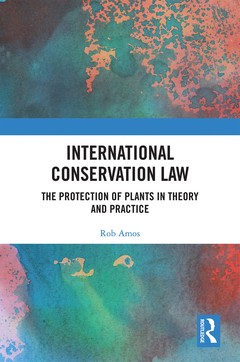International Conservation Law The Protection of Plants in Theory and Practice
Auteur : Amos Rob

Through a combination of theoretical and empirical approaches, this book explores the role of international environmental law in protecting and conserving plants.
Underpinning every ecosystem on the planet, plants provide the most basic requirements: food, shelter and clear air. Yet the world?s plants are in trouble; a fifth of all plant species are at risk of extinction, with thousands more in perpetual decline. In a unique study of international environmental law, this book provides a comprehensive overview of the challenges and restrictions associated with protecting and conserving plants. Through analysing the relationship between conservation law and conservation practice, the book debates whether the two work symbiotically, or if the law poses more of a hindrance than a help. Further discussion of the law?s response to some of the major threats facing plants, notably climate change, international trade and invasive species, grounds the book in conservation literature. Using case studies on key plant biomes to highlight the strengths and weaknesses of the law in practice, the book also includes previously unpublished results of an original empirical study into the correlations between the IUCN Red List and lists of endangered/protected species in international instruments. To conclude, the book looks to the future, considering broader reforms to the law to support the work of conservation practitioners and reshape humanity?s relationships with nature.
The book will be of interest to scholars and students working in the field of international environmental law and those interested more broadly in conservation and ecological governance frameworks.
TABLE OF CONTENTS
Foreword
Preface and Acknowledgements
Table of International Agreements
PART 1: PRELIMINARY ISSUES
Introduction: The Legal and Ecological Context of Plant Conservation
Why a Book About Plants?
A Brief Introduction to Plant Ecology
Core Themes and Structure
Chapter I: The Value of Plants
Nature in International Environmental Law
Why Is Understanding Value Important?
Interpretations of Value
Anthropocentricity in International Environmental Law
Conclusions
PART 2: THE INTERNATIONAL LEGAL FRAMEWORK FOR THE PROTECTION OF PLANTS
Chapter II: Global Approaches to the Protection of Plants
Tensions in International Conservation Law
The 1992 Convention on Biological Diversity
Forest Biodiversity
Conclusions
Chapter III: Regional Approaches to the Protection of Plants
Regional Conservation Instruments and ‘Effectiveness’
The Geographic Scope of Regional Conservation Agreements
The Construction of Regional Conservation Agreements
The Relationship between Regional Conservation Agreements and Conservation Practice – Designating Protected Areas
The Relationship between Regional Conservation Agreements and Conservation Practice – Listing Species
Conclusions
Appendix 1: Ratification Status of the Regional Conservation Agreements
Appendix 2: Methodological Notes for the Empirical Study on the Conservation and Population Status of European Flora
Chapter IV: Polar Plants
Plants at the Poles
Plants in the Antarctic Treaty System
The Conservation of Arctic Flora
Conclusions
Chapter V: The Protection of Marine and Freshwater Plants
Plants in Aquatic Ecosystems
Global Approaches to Marine Conservation
Regional Approaches to Marine Conservation
The Conservation of Flora in Wetlands
Freshwater Flora
Conclusions
PART 3: LEGAL RESPONSES TO THE DRIVERS OF PLANT DIVERSITY LOSS
Chapter VI: Climate Change
Plants and Climate Change
Conservation and Climate Change
The Conservation of Mountain Plants
The REDD+ Programme
The Clean Development Mechanism
Conclusions
Chapter VII: International Trade
Plants in International Trade
The Environment and Trade
Protecting Plants through the Environmental Exceptions in the GATT
The 1973 Convention on International Trade in Endangered Species
Conclusions
Chapter VIII: Invasive/Alien Species, Disease and Ecosystem Restoration
The Threat of Invasive/Alien Species and Disease
International Regulation of Invasive/Alien Species
Controlling the Spread of Disease
Rewilding and Ecosystem Restoration
Conclusions
PART 4: WAYS FORWARD FOR THE PROTECTION OF PLANTS
Chapter IX: Conservation Practice and International Law
Resilience Thinking in Conservation
Non-State Actors in Conservation
Key Components of Successful Conservation
Making International Law Work for Conservation – The Nagoya Protocol on Access and Benefit-Sharing
Conclusions
Chapter X: Ecological and Ecocentric Models for Reform
The False Promise of Neoliberalism and Sustainable Development
Defining Ecological Sustainability
Templates for an Ecocentric Society
Recognising the Legal Rights of Plants in International Law
Conclusions
Conclusion: Humanity’s Failure to Protect Plants
Bibliography
Rob Amos is the Academic Lead on the environmental strand of UCL’s Global Citizenship Programme.
Date de parution : 12-2021
15.6x23.4 cm
Disponible chez l'éditeur (délai d'approvisionnement : 14 jours).
Prix indicatif 50,12 €
Ajouter au panierDate de parution : 05-2020
15.6x23.4 cm
Thèmes d’International Conservation Law :
- droit de l'environnement
- Économies et politiques économiques mondiales : relations économiques internationales / douanes, exportation
- Biologie
- Hydrologie - géologie marine - océanographie - océanologie
- Droit, généralités
- Productions végétales
- Sciences politiques
- droit communautaire / droit européen
- écologie / protection de l'environnement
- réchauffement climatique
Mots-clés :
Ballast Water Convention; humanity's relationships; Natural Genetic Resources; international trade; IUCN Red List; international environmental law; International Law; invasive species; Public International Law; National Plant Protection Organisation; Balaenoptera Musculus; Antarctic Treaty System; Biodiversity Convention; ASEAN Agreement; Nagoya Protocol; Above Ground; Article Iv; Article XX; Appellate Body; Wild Law; Antarctic Specially Protected Areas; Ballast Water Management; Antarctic Treaty; Arctic Flora; Ballast Water; Aichi Targets; Public Engagement; Sea Turtles



